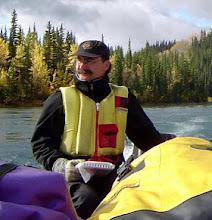


We have a tradition of canoe trips as the family holiday. For many years we 've spent our summers paddling different stretches of the Yukon's Rivers, and now we're ready to do the same in New Zealand. We arranged a trip through a local outfitter and picked up canoe, paddles, kitchen and barrels in Taumarunui. Erin and Joy had planned our meals - couscous, stir frys and pasta - and expertly packed our six barrels with clothing and food. By mid-morning we launched.
The Whanganui River is one of the few "navigable" rivers of any length, ~230 km, in New Zealand. Our trip would cover the upper 145 km, in the course of which we would be challenged by 196 rapids and other river obstructions. But in the late 1800s, steamers began travelling up the river and blasting of rocks and building of weirs remade the river to ease their passage. Still it must have been a challenge pushing a boat up this river.

Our first day included 67 rapids so the adrenaline level was high as we approached the first twisting bend of the river. We stopped, walked the shingle bar dividing the river into a back slough of willows and the frothing whiteness of stones that was supposed to be the main channel. Patrick and Linda, a German couple, decided to line down through the willows so Erin, as lead Canadian, made us run the froth. We paddled across the channel and turned into the foam. Remarkably as we entered the rapid, the river seemed to slow and guiding the canoe through the rocks came easily. A whoop as we passed the last boulder and we were through. With all the practice, confidence built quickly (not so sure about our rusty skills though). Soon we just eyeballed the fall as we approached and went for it. The sunshine and spray made for an exhilarating first day. Our outfitter's launch remark, "It's a pink, not white, knuckle experience," seemed true enough.

We camped at Poukaria, shady and cool. Over a convivial dinner we got to know our travelling companions. In addition to Patrick and Linda, there was young British couple, Amy and Alex, also on their first canoe trip. For the next three days these were the only people we would see on the river. We had passsed through pasture lands early in the day but by evening, hills were rising around us and there were no signs of human habitation. Later we learned Poukoria was one of between twenty to thirty Kianga (Maori camps) on that first stretch of water. Hardly an empty land.

A 1921 river guide nostalgically noted;
To-day the valley land is all taken up, and for some years thousands of sheep have occupied the ancient battlefield and hunting grounds of the Maori. When the writer first went up the river over 30 years ago all these old Kainga were picturesque scenes of Native activity, and the shrill chorus of the Haere-mai welcome as the stranger's canoe came near can never be forgotten. But alas! gone from the upper river is all that pertains to the old-time Maori; gone is the grand fleet of canoes that carried their complement of 50 to 100 warriors, when warlike occasions demanded, or on peaceful visitations, food gathering expeditions. No more does the old-time Native craftsman ply his peaceful arts in river or forest, hewing out his well-designed canoe or carving his wonderfully grotesque figures. He has gone and with him is going the lordly forest primeval, with its dark shadows, its ever changing lights and shades, its noble ratas towering above every bluff and covering the lofty hill sides with sheets of flaming red; and with the trees the birds. But enough - who would hinder these marks of progress?


e.jpg)
.JPG)


No comments:
Post a Comment